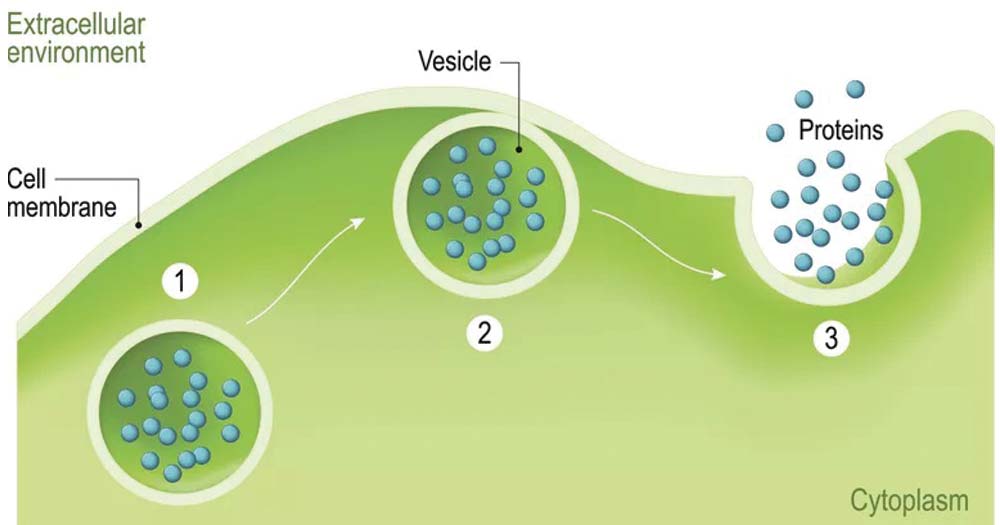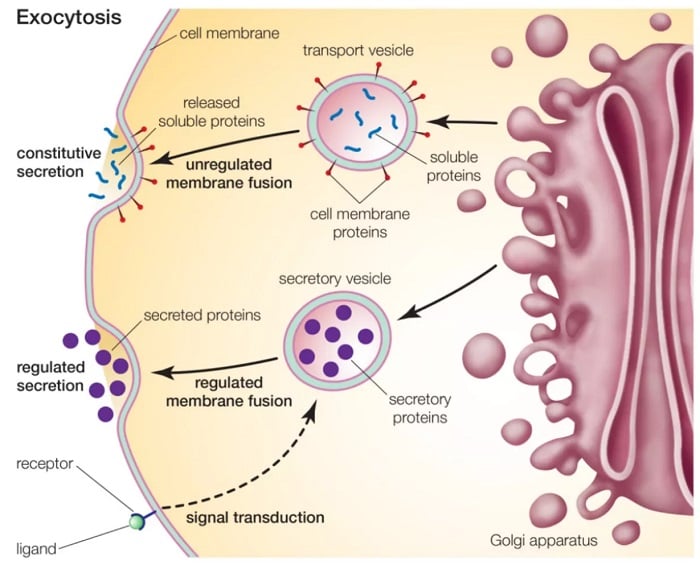Interesting Science Videos
What is exocytosis?
- As compared to endocytosis, exocytosis is a process that is used to transport materials from inside the cell to the external part of the cell by the use of energy. Therefore, it is a type of active transport mechanism and it is the opposite of endocytosis. Generally, in this mechanism of exocytosis, a special vesicle bound to the cell membrane, containing the cellular particles will expel the cell content to the external part of the cell.
- This mechanism has been used in the removal of waste materials from the cell, transport hormones, and proteins, for chemical signaling between cells and the construction of the cell membrane. The vesicles involved in exocytosis are formed by the Golgi bodies, endosomes, and the presynaptic neurons. These vesicles fuse with the cell membrane and they can either be complete or temporary vesicles, depending on their function.
- Normally after endocytic pinocytosis and phagocytosis, the cell membrane gets damaged, and therefore the exocytic process functions to repair the cell membrane by transporting proteins and lipids to the membrane for repair mechanisms.
- It is also the end-point mechanism for the transportation of protein complexes and packaging them in their destined sites and insertion to the cell membrane.
Read also: Endocytosis- Definition, Process, and Types with Examples
Exocytosis mechanism in Summary

Image Source: ThoughtCo
Exocytosis mechanism in summary involves:
- The transportation of the cell vesicle containing molecules from inside the cell to the cell membrane.
- The vesicle then attaches to the cell membrane.
- During vesicle fusion with the cell membrane, it allows the release of the contents in the vesicle to the outside of the cell.
The Exocytotic Vesicle
- The exocytotic vesicle contains protein elements that are acquired from the Golgi complexes, which are the recipients of the proteins and lipids that are synthesized in the Endoplasmic reticulum.
- The Golgi complexes’ function is to sort and modify proteins and stored within the secretory vesicle, which buds off at the trans face of the Golgi apparatus.
- However, not all vesicles that fuse with the cell membrane gain contact with the Golgi apparatus, some are formed from the early endosome, a membrane sac found in the cell cytoplasm. The vesicle fuses with the early endosome by endocytosis of the cell membrane, sorting the internalized elements into proteins, lipids, microbe, and directs them to their destinations, using transport vesicles. The transport vesicles then bud off from the early endosome, transporting the proteins and lipids to the cell membrane and waste materials to the lysosomes where they are degraded.
- Another type os vesicles that do not originate from the Golgi complexes are those found on the synaptic terminals of the neurons.
Types of Exocytosis

Figure: Types of Exocytosis. Image Source: ThoughtCo
There are three pathways involved in the exocytotic process.
- Constitutive exocytosis
- Regulated exocytosis
- Lysosome mediated exocytosis
Constructive exocytosis
- This type of exocytosis involves the delivery of membrane proteins and lipids to the cell membrane and to also get rid of substances from the cell into the exterior. This is the most common pathway that is performed by all body cells.
Regulated Exocytosis
- This mechanism is common among the secretory cells whose function is to store hormones, digestive enzymes, and neurotransmitters.
- The secretion of these products must be triggered by extracellular signals to initiate the formation of secretory vesicles, which fuse with the cell membrane for a long time to allow the release of the cell contents out of the cell, into the exterior. After delivery, the vesicles are reformed and returned to the cytoplasm.
- Generally, this mechanism depends on extracellular signaling for the release of its content onto the outer part of the cell.
Lysosome mediated Exocytosis
- This process involves the fusion of cell vesicles with the cell lysosomes. Lysosomes contain digestive enzymes and hydrolase enzymes whose function involves the breakdown of cellular waste materials, microorganisms, and debris. The lysosome carries the elements that have been broken down onto the cell membrane where it fuses with the cell membrane releasing its elements into the extracellular cell matrix.
Of the three discussed pathways, constructive exocytosis is the regular exocytotic mechanism that takes place in four steps while the regulatory exocytosis takes place in five steps. The steps include:
- Vesicle trafficking – The cell vesicles are transported to the cell membrane through the microtubules of the cytoskeleton with the help of the motor proteins such as kinesins, dyneins, and myosins.
- Tethering – When the cell vesicles reach the cell membrane that is pulled toward the cell membrane and they eventually come into contact with each other.
- Docking – This is the attachment of the vesicles with the cell membrane, initiating the merging of the phospholipids of the vesicle membrane with that of the cell membrane.
- Priming – This step takes place in the regulated exocytosis and not in the constitutive exocytosis. There are modifications that take place in some of the cell membrane elements for exocytosis to take place, which assist in signaling processes that trigger exocytosis.
- Fusing – two types of fusion are involved in exocytosis i.e complete fusion and temporary (kiss-and-run) fusion. Complete fusion involves the full fusion of the vesicle membrane with the lipid cell membrane by the use of energy (ATP) and also they use energy to separate both the vesicle membrane and the cell the membranes after the cell content has been released. While in temporary or kiss-and-run fusion, the vesicle temporarily fuses with the cell membrane for a period of time to allow the formation of the fusion pore for releasing the cell content to the exterior of the cell. The vesicle then detaches from the cell membrane where it reforms and returns to the cell cytoplasm.
Exocytosis Examples
- A good example of exocytosis in the transportation of glucagon from the pancreas in the Islets of Langerhans into the liver where they are broken down into glycogen which is further broken down to glucose which is simple for absorption. The glucose is then released into the bloodstream.
- In the islets of Langerhans, the glucagon and insulin are stored in the secretory vesicles of the pancreas. When the glucose levels in the bloodstream are low, glucagon is secreted by the islets alpha cells, carried by the secretory vesicles into the liver cells where they are released by exocytosis for further processing and utilization.
- The pancreas also releases some digestive enzymes by exocytosis.
- Other exocytotic processes include the synaptic vesicle exocytosis where a synaptic vesicle filled with neurotransmitters in the pre-synaptic neuron fuses with the pre-synaptic membrane releasing neurotransmitters into the synaptic cleft (the gap between neurons). The neurotransmitters can then bind to receptors on the post-synaptic neuron.
References and Sources
- 10% – https://www.thoughtco.com/what-is-exocytosis-4114427
- 2% – https://www.coursehero.com/file/pj97lsd/The-neurotransmitters-bind-to-receptors-on-the-post-synaptic-cell-and-the/
- 1% – https://www.yourhormones.info/hormones/glucagon/
- 1% – https://microbenotes.com/endocytosis-definition-process-and-types-with-examples/
- 1% – https://courses.lumenlearning.com/biology1/chapter/active-transport/
- 1% – http://oregonstate.edu/instruction/bi314/summer09/golgi.html
- <1% – https://www.researchgate.net/publication/6711754_Mechanisms_of_peptide_hormone_secretion
- <1% – https://www.researchgate.net/publication/6247040_The_Forces_Behind_Cell_Movement
- <1% – https://www.coursehero.com/file/p6pg6c4/2-membrane-of-the-vesicle-fuses-with-the-plasma-membrane-3-fusion-with-the/
- <1% – https://wikispaces.psu.edu/display/Biol230WFall09/Intracellular+Compartments-+Exocytosis%2C+Endocytosis%2C+and+the+Lysosome
- <1% – https://quizlet.com/7496792/pancreas-flash-cards/
- <1% – https://quizlet.com/71522023/cell-biology-flash-cards/
- <1% – https://quizlet.com/62356508/cell-bio-exam-4-flash-cards/
- <1% – https://quizlet.com/205595149/neuronal-synaptic-biology-flash-cards/
- <1% – https://biologywise.com/mechanism-of-receptor-mediated-endocytosis-explained
